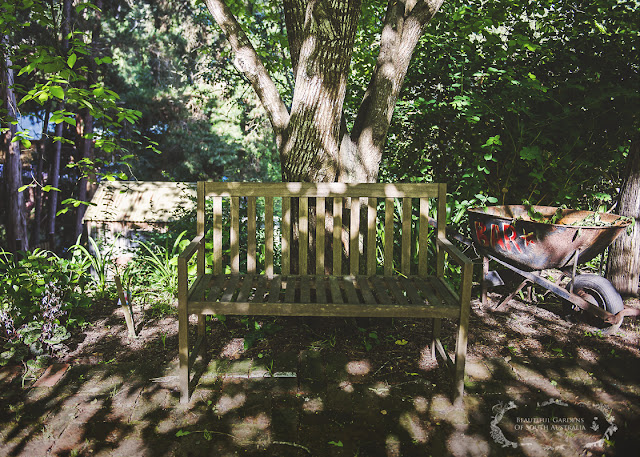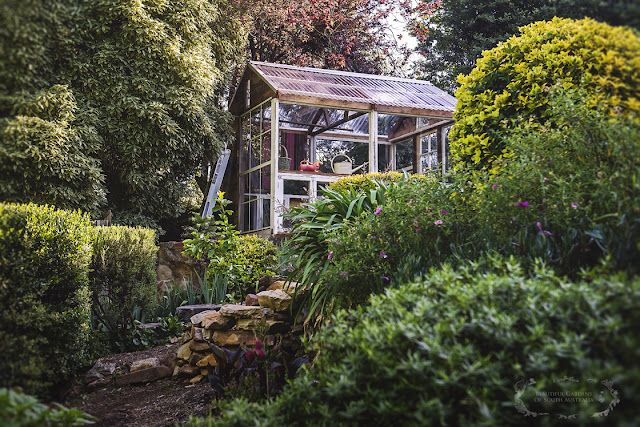When the time came to find their very own patch of earth, Noel and Rebecca had the daunting task of trying to find somewhere they felt they belonged, as much as it would belong to them. At the open inspection of their Bridgewater property, Noel fell instantly in love with the garden and made his offer there and then. All without Rebecca even seeing the place! It was that sense of home, and the huge golden elm tree that got them hooked!
Two and a half years later, they have transformed the garden. When they took ownership of the property, the steep slope had been terraced with beautiful freestanding retaining walls, with mature trees and a few basic plants and shrubs. But it also came with a whole lot of weeds and agapanthus! The basic landscaping all done, they had the big task of cleaning up the area and creating a space that is useable, family and dog friendly whilst also allowing them to indulge in their creativity.
Because of where they are situated, in the Adelaide hills, the property receives little to no sunshine in winter because of the tall northern trees. And it gets full sun in spring and summer. It is a garden where much thought and planning had to be put in. They have to contend with harsh cold winters, with nasty frosts that burn tender plants, and long hot, dry summers. They are surrounded by huge trees, some of which are pines, that block the light and suck moisture and nutrients from the soil.
Noel and Rebecca were up for a huge challenge! One that, I believe, they have won hands down!
This place is magical. I fully understand why they bought the property. It is a perfect home for children, to escape the house and discover and learn. A place to have chickens and build a garden, to listen to the myriad of birds, as they nestle high in the trees. And a perfect place for adults. A place to rest, to think a while, to feast your eyes, or simply close them, listen and breathe.
(if you want to fill your computer screen with the garden pictures, simply click on the first one and it will be like a gallery. )

The front part of the garden is not big, as the house sits fairly close to the road. It was originally covered in Agapanthus plants, of which most have been removed and replaced. Daisies, hibiscus, violets, ( which will look perfectly sweet when they flower )
acanthus mollis, and a smoke bush are just some of the beautiful plants that are growing in the bordered beds.
Acanthus Mollis. Fantastic, drought tolerant and hardy perennial.
The gum tree, below, is a particular species that only grows in the Bridgewater area. There are not very many to be found in the local gardens, as their habit is a bit messy and introduced plants have taken over. Noel has been nurturing it and it's thriving! It can be found along the trail of Cox Creek, towards Engelbrecht Reserve. The Smoke bush on the right is a favourite of mine. The leaves are a stunning burgundy all year round, and the flowers resemble puffs of smoke, drifting in the breeze!
 Lobelia crystal blue eyes
Lobelia crystal blue eyes. What a gorgeous colour!
Anisodontea Elegant and Crimson Bottlebrush.
The adventures begin when we move towards to rear garden! My goodness! It is simply stunning!
Noel and Rebecca have worked very hard to put in the inviting lawn and all the plants surrounding it. Noel has created paved pathways and steps, making it easier and safer to move throughout the garden, especially when there are chickens to feed at the bottom of a very steep slope!
Aren't those ferns in the back border amazing!
Because it gets lots of spring and summer sunshine, they have also planted a few fruit trees, including Johnathan and Golden Delicious apples, Green gage and Angelina plums, raspberries, rhubarb and lots of herbs.
Alstromereum or Princess Lilly.
It grows like a weed and you need to keep it under control. But it is still very pretty! - Rebecca
There was a part of the garden that was unused and wasted. It was decided that this would be a great spot for a glass house. Noel likes to salvage/recycle materials where he can. It saves money and it makes the finished piece of work special and unique.
He spent many months gathering the materials, from Gumtree, newspaper ads and family before he could even begin. ( Check out the blog post showing how he built it.
Here)
I am literally green with envy! I love it!
The door handle he found in his Dad's shed, and he added a little brass knob on the other side
to help close it!
He recycled old wooden pallets for the walls, and used linseed oil to preserve and protect the wood.
In use already, Rebecca has just completed a course in propagating and has been nurturing and growing her own plants. In time it will save them so much money!
Noel also likes to use the space as a reading and writing room.
Their son's watering can. Super cute!
Fuscia Whiteknights Blush growing as a big bush next to the glasshouse.
Sunflowers, planted in old toilet rolls make great little starter containers.
Noel tells me that they don't like their roots to be moved very much. By growing them this way, they can be started off in the glasshouse, and popped straight into the soil! There is going to be an amazing show of flowers soon!
While looking around the garden, Noel pointed out an amazingly coloured blue ant! It was iridescent and big. I was lucky enough to get a quick snap before it moved away. When I got home I looked it up and found out that yes, it is indeed real, but no, it isn't actually a ant! Even thought it is referred to as a blue ant, it is actually a female, wingless wasp. They are solitary and have an erratic walk! Which is why I found it hard to get a good photo!
Maple Vitifolium, which produces the most amazing display of colour in autumn.
Views of the gorgeous little glass house, where children are free to explore, adventure and play!
Noel's father built a boat many years ago. He remembers going out in it once or twice, and after that it was never used. When his parents sold their property, Noel took it home. It is now used as a fish pond, complete with goldfish (that the birds keep devouring ) and sweet water lilies. Obviously it has stood the test of time, because even filled to the brim with water, it doesn't leak!
It is just lovely and so inspiring! Even the post it is secured to is a salvaged bit of old fencing!
These two gardeners are just so clever and creative!
Convolvuls Sabitius or moroccan Beauty
Moving further down into the garden, I am anticipating what I will find, hidden beneath the old elm. Like little vignettes and garden rooms, there is a desire in me to look further and see more.
Walking past the Lambs ears, Lavender and garden paths, I finally get a glimpse of what sits below.
Golden Elm and Lambs Ears.
The path leads down into a shady grove.
The temperature drops and everything is filtered with a subtle green light. The garden bench is a cool and quiet spot to sit in summer. And in winter, when the leaves have all fallen, you can look up at the garden, simply enjoying the view.
It truly feels like a little place of magic. Where delicate, shade loving plants might poke their heads from the soil and a person can put away all the cares of the world.
The family celebrates their christmas day down here, in the cool shade, with a big long table. It is the perfect place for a gathering. Everything about this space is a celebration of growth, greenery and garden!
The old ruins.
When Noel and Rebecca first bought the property, what was left of the old building was filled to the brim with rubbish! Why on earth someone would fill something of historical value with waste is beyond me! It took them months to get rid of it all. Noel then paved the base, once again sourcing and using recycled bricks. The walls are made with basic clay and local stone, so he is unsure what the building was originally used for. Possibly as a stable.

Noel scored those posts from his Dad's place too!
You don't find many sculptures in this garden, but the love and history that has been put into it has so much more soul. I did, however, find this little birdie, perched in his nest on one of the old posts.
That old gramophone hanging on the walnut tree is used as a loud speaker! Yes, it works! Noel put his iPhone into it, and played some music. Very cool! And It looks fantastic.
Almost like a big flower.
Of course, they never get to enjoy the walnuts, as the birds generally get to them before they even ripen!
One of Noel and Rebecca's favourite things in the garden is the delicate moss, growing over the rocks. It's one of those plants, like lambs ears, that you just have to touch!
Impatiens

More garden paths, and there is still one other place to go! Do you get the feeling that this is much more than a quarter acre garden?
Noel has bordered this one with Hydrangea's and Clivia. Once they have established, it is going to be a beautiful place to walk.
We are heading down to the chickens! I love chickens!!
Once again, ( is this not the most amazing garden for salvaged material ideas? ) Noel has built his own sweet chicken coop! Those girls have got the life!
They all have their own names! That's Jellybean up the top, and there is one named Shirley, another called Big Red and the little white one is called Pidge, because she was the size of a pigeon when they got her. She lays blue tinted eggs! Aren't they such pretty girls!
Of course, after we had seen them, we had to let them out!
Straight into the garden for a dust bath and to eat their greens!
Noel also built his boys a cubby house.
He used old pallets for this too, a recycled old door, which he cut down to size, and a little salvaged glass window. He says it is big enough to sleep in. I wonder if his boys have tried that out!
The property ends with another stone wall. Below that is a communal path, which the surrounding houses use to walk through to access the train track and street. Even the path is mysterious and poetic!!
I love that a 1/4 acre garden seems so much bigger.
The combination of neighbours houses being hidden, fences invisible and the slope into the valley with mature plantings linked by paths, makes it a place that you can explore and constantly find something new. - Noel.
Heuchera Americana. All Heuchera's are lovely additions to a shady spot. - Rebecca


Aquilegia
Secret pathways.... Made by their dog!
Red Clivia. A great hardy plant for dry shady places.
Those chookie girls didn't take long to get out and about!
What a view from the back veranda. Beautiful!
The Earth Laughs In Flowers.
After many years of renting, we chose a house for it's garden. It's a fantastic creative and physical outlet, the kids love it, the dog loves it. We love it. - Noel & Rebecca.


































 Lobelia crystal blue eyes. What a gorgeous colour!
Lobelia crystal blue eyes. What a gorgeous colour!


































































